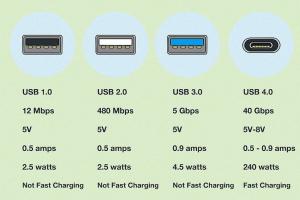Mastering USB Cables: How to Identify Hi-Speed & Fast Charging Support

-
Quick Links:
- Introduction
- Understanding USB Standards
- Key Features to Spot Hi-Speed and Fast Charging Cables
- Testing Your USB Cable
- Real-World Examples
- Expert Insights
- Common Issues with USB Cables
- Conclusion
- FAQs
Introduction
In a world where technology is evolving rapidly, understanding the tools we use daily is essential. USB cables are at the heart of charging and data transfer for many devices. However, not all USB cables are created equal. This guide will dive deep into how to tell if a USB cable supports hi-speed and fast charging, ensuring you get the most out of your devices.Understanding USB Standards
USB (Universal Serial Bus) technology has come a long way since its inception. The most common standards to be aware of include: - **USB 2.0**: Supports data transfer rates up to 480 Mbps. - **USB 3.0**: Known as USB 3.1 Gen 1, supports data transfer rates up to 5 Gbps. - **USB 3.1**: Also known as USB 3.1 Gen 2, supports up to 10 Gbps. - **USB Power Delivery (PD)**: A protocol that allows for higher power levels, enabling fast charging for compatible devices. Each standard has its specifications regarding power delivery and data transfer rates, significantly impacting charging capabilities.Key Features to Spot Hi-Speed and Fast Charging Cables
To determine if a USB cable supports high-speed and fast charging, look for the following features: 1. **Cable Markings**: Many manufacturers mark their cables. Look for symbols indicating USB 3.0 or higher. 2. **Connector Type**: USB-C connectors tend to support higher power levels and faster data transfer compared to older USB types. 3. **Wire Gauge**: Thicker wires (lower AWG numbers) can handle more current, which is essential for fast charging. 4. **Length of the Cable**: Shorter cables generally have less resistance, which can help with faster charging. 5. **Compatibility with Fast Charging Protocols**: Look for compatibility with protocols like Qualcomm Quick Charge or USB PD.Testing Your USB Cable
If you’re unsure whether your USB cable supports hi-speed and fast charging, you can test it yourself. Here’s how: 1. **Use a Multimeter**: Measure the voltage and current flowing through the cable while charging. A cable capable of fast charging will typically deliver higher voltage (9V or 12V) and current (2.1A or higher). 2. **Fast Charging Testers**: Purchase a USB tester that can show you the power output of your cable. 3. **Compare Charging Speeds**: Use a device that supports fast charging and compare charging times with known cables.Real-World Examples
Consider the case of a user who experienced slow charging with their phone. Upon inspection, they found they were using a standard USB 2.0 cable. Switching to a certified USB 3.0 cable significantly improved charging times. Additionally, many smartphone manufacturers provide specific cables designed for their devices. Using these cables often ensures optimal performance.Expert Insights
Industry experts recommend always looking for certified cables from reputable brands. Non-certified cables may not only underperform but can also pose safety risks. For example, a study conducted by the Consumer Electronics Association found that over 30% of non-certified cables failed to deliver the expected power output, leading to longer charging times and potential device damage.Common Issues with USB Cables
1. **Frayed Wires**: Over time, cables can wear out, leading to inconsistent charging. 2. **Compatibility Issues**: Not all cables work with every device, especially when it comes to fast charging. 3. **Counterfeit Products**: Beware of counterfeit cables that may not meet safety standards.Conclusion
Understanding how to identify hi-speed and fast charging USB cables is crucial for optimizing your device's performance. By paying attention to cable specifications, testing your cables, and investing in certified products, you can ensure efficient charging.FAQs
- 1. How do I know if my USB cable is fast charging?
- Check for markings indicating USB 3.0 or higher and test the charging speed.
- 2. Can I use any USB cable for fast charging?
- No, only cables designed to support fast charging protocols will work effectively.
- 3. What is the difference between USB 2.0 and USB 3.0 cables?
- USB 3.0 cables support higher data transfer speeds and power levels than USB 2.0 cables.
- 4. Are all USB-C cables fast charging?
- No, not all USB-C cables support fast charging; check for specifications.
- 5. How can I test my USB cable's charging speed?
- Use a multimeter or a USB power meter to measure voltage and current.
- 6. Is it safe to use a non-certified USB cable?
- Using non-certified cables can pose safety risks and lead to device damage.
- 7. What should I look for in a fast charging cable?
- Look for thick wires, proper certifications, and compatibility with your device’s fast charging protocols.
- 8. Can long cables affect charging speed?
- Yes, longer cables can introduce resistance, which may slow down charging.
- 9. Do all devices support fast charging?
- No, only devices specifically designed for fast charging will benefit from it.
- 10. How often should I replace my USB cables?
- Replace your cables if they show signs of wear or if charging performance diminishes.
Random Reads
- How to treat woodworm
- How to troubleshoot a dryer that smells like burning
- How to start a boiler
- How to start hearthfire
- How to replace a door trim
- How to replace a garbage disposal
- Ultimate guide to starting your streaming career
- How to restore sun damaged plastic
- How to subnet a class c network
- How to strip coax cable